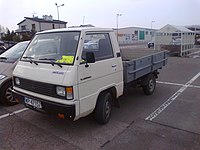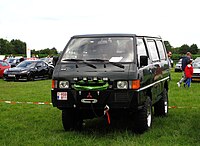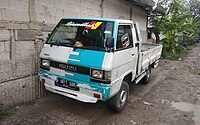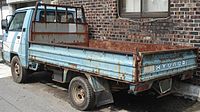Mitsubishi Colt L300
| Mitsubishi Colt L300 | |
|---|---|
 Mitsubishi Colt L300 pickup (2021, Indonesia) | |
| Informasi | |
| Juga disebut |
|
| Masa produksi |
|
| Perakitan |
|
| Bodi & rangka | |
| Bentuk kerangka |
|
| Tata letak | |
| Penyalur daya | |
| Mesin |
|
| Transmisi | |
| Dimensi | |
| Jarak sumbu roda |
|
| Panjang |
|
| Lebar |
|
| Tinggi |
|
| Berat kosong | 930–1.165 kg (2.050,3–2.568,4 pon) (RWD) |
Seri Delica diganti pada Juni 1979 dengan desain baru, sehingga lebar keseluruhan menjadi maksimal 1.690-milimeter (67 in) ditentukan oleh peraturan Jepang untuk kendaraan "kompak".[6] Ditangguhkan di bagian depan oleh konstruksi independent wishbone dan leaf spring di bagian belakang, Delica juga dilengkapi pintu samping geser dan one-piece gas strut pintu belakang.[1] Line-up diperluas untuk memasukkan sepuluh variasi model yang mencakup berbagai macam penumpang (delapan kursi dalam konfigurasi tiga/dua/tiga[7]), kargo dan aplikasi rekreasi. Opsi penggerak empat roda tersedia pada tahun 1982, yang pertama di pasar van Jepang. Mesin semua empat silinder terkenal dari mobil penumpang MMC dan termasuk 1.439 cc, 80 PS (59 kW) Saturn (4G33) and mesin 1.6-liter Saturn (4G32). A 1.8-liter Sirius (4G62) version producing 100 PS (74 kW) muncul pada Mei 1980, dan versi bensin 2.0 liter Sirius (4G63B) menjadi opsional dalam versi 4WD mulai November 1983.[8] Sebuah 2,3 liter Astron (4D55) diesel muncul pada bulan Oktober 1982 dan digantikan oleh 2,5 liter yang lebih besar Astron (4D56) pada tahun 1986.
Delica versi penggerak empat roda pertama kali diperkenalkan ke pasar Jepang pada Oktober 1982.[8] Kendaraan serbaguna ini menggunakan versi modifikasi dari sasis Mitsubishi Pajero, meskipun biasanya dengan mesin yang lebih kecil (awalnya hanya bensin 1,8 liter).[7] Setelah Delica generasi ketiga diperkenalkan, versi truk (kabin terpisah) dari generasi kedua terus diproduksi hingga tahun 1994. Konsumen Jepang dikenakan pajak tahunan yang lebih tinggi pajak jalan karena mesin yang lebih besar dipasang di paket tingkat trim yang lebih tinggi.
-
Pre-facelift Mitsubishi L300 van (Chili)
-
Pre-facelift Mitsubishi Delica high roof van (Jepang)
-
First facelift Mitsubishi L300 converted to a recreational vehicle (Eropa)
-
Second facelift Mitsubishi L300 pickup (Eropa)
-
Mitsubishi Delica pickup (Jepang) with double rear tires intended for heavier payload duty
-
Mitsubishi Delica Star Wagon 4WD (Selandia Baru)
-
Mitsubishi L300 Star Wagon 4-pintu high roof van (Selandia Baru)
-
Mitsubishi L300 4x4 van (Eropa)
Pasar
Australia
Chrysler Australia introduced the SA series Delica to the Australian market on 14 April 1980 under the name "Chrysler L300 Express" after debuting at the Adelaide Motor Show in 12 April.[7][9] After acquiring control of the Chrysler Australia operations in the same month,[10] Mitsubishi Motors renamed the firm Mitsubishi Motors Australia in October 1980.[11] This resulted in the rebranding of the L300 Express as a Mitsubishi.[7] Fitted with a 1.6-liter engine and four-speed manual, both van (three-seater commercial) and wagon (eight-seater) variants were offered, with the commercial (van) version available with or without side rear windows.[7][12] The utility (pickup) version was not sold in Australia, as the L200 Express covered that segment of the market.[7] In November 1981 the SB series was introduced, now fitted with radial ply tires on larger diameter wheels, thus increasing the payload capacity from 925 hingga 1.000 kilogram (2.039 hingga 2.205 pon).[7] The following month, Mitsubishi introduced the high-roofed luxury "Deluxe" trim, fitted with electric sunroof and cloth upholstery.[7] The next update to the SB series arrived in October 1982, resulting in the "Deluxe" trim being renamed "Starwagon" and gaining a larger 1.8-liter engine—offered with a five-speed overdrive manual or optional three-speed automatic.[7] The "Star Wagon" (this was written either as one or as two words) moniker was also used on examples assembled by Todd Motors in New Zealand, albeit with the 65 PS (48 kW) 1.6-liter engine.[13] Mitsubishi extended the availability of the 1.8-liter engine to the lower-specification variants, albeit in automatic guise only.[14] The 1.8 was also available in the long wheelbase, high roof, panel van version.
From May 1983, the L300 Express received rectangular headlights in chrome surrounds as part of the SC iteration.[7] The SC also featured newly designed black resin bumpers and adjustments to the front suspension spring rate to improve ride and handling.[15] The four-wheel drive version, badged "4WD", came in October 1983 as a 1.8-liter model with floor-mounted five-speed manual only, therefore becoming a seven-passenger model by losing the front-row center seat.[7][16] After another facelift in October 1984, the car became the SD series, introducing better equipment and black headlight surrounds along with a black trim piece between the headlights on "Starwagon" and "4WD" trims.[17][18] The SD revision also upgraded the "4WD" to a 2.0-liter engine, with the 1.8-liter standard issue in a new long-wheelbase commercial (van) model.[17] A final minor update, the SE series appeared in 1986.[19]
-
Mitsubishi L300 Express van (SB, Australia)
-
Mitsubishi L300 Express high roof van (SB, Australia)
-
1985 Mitsubishi L300 Express panel van (SD, Australia)
-
Mitsubishi L300 Express 4WD van (SD, Australia)
Asia
- Philippines
This generation has been produced in the Philippines since 1987 as the "Mitsubishi L300 Versa Van" (discontinued in April 2012) as well as the Cab/Chassis variant where local coach builders assemble rear bodies for passenger and cargo hauling purposes. Variations such as the FB (family business), PET (personal and equipment transport), WT (water tight aluminum van) and DS (drop side) have been made to cater to those needs. In 2010, an extended rear body variant for the FB variant called the Exceed was added. In 2014, local truck body manufacturer Centro Manufacturing launched a minibus version of the L300 called the XV Mikrobus. It is built on the FB Exceed platform and is meant to be used as a public utility vehicle, a school bus, or an ambulance. It is also meant to revive the Versa Van and to be an alternative to the FB variant.[20] In 2017, Mitsubishi Motors Philippines announced that the L300's diesel engine will be updated to comply with the Euro 4 standardization project of the DENR and the LTFRB.[21][22][23] In April 2019, Mitsubishi Motors Philippines announced that the L300 would be fitted with the 4N14 CRDi engine.[24] From 1987 to 2009, the design of the front fascia haven't changed much for 22 years (although there were minor changes to the interior). The L300 received a facelift in 2010 and was sold until 2017. Mitsubishi updated the styling of the L300 for the 2019 model year, now featuring the new horizontal chrome grille similar to the "Dynamic Shield" design language found on other Mitsubishi models like the Mitsubishi Xpander, Mitsubishi Montero Sport to distinguish it from older L300s.
In 2020, the local production of the L300 reached 200,000 units,[25] and exports has been said under consideration.[26]
-
Mitsubishi L300 Versa Van (pre-facelift; Philippines)
-
L300 FB Deluxe (rear view; pre-facelift)
-
2010–2017 Mitsubishi L300 Prisoner Van coachbuilt by Centro Manufacturing (first facelift; Philippines)
-
2019 Mitsubishi L300 (second facelift; Philippines)
- Indonesia
As of November 2021, this generation is still in production in Indonesia as the Colt L300,[27] equipped with the 2.5-liter 4D56 diesel engine. The production started in 1981, the car was equipped with a 1.4-liter 4G33 petrol engine. Minor facelift occurred in 1984, the round shape headlights were replaced with square unit. The engine was also replaced with a more powerful 1.6-liter 4G32 petrol engine and also a 2.3-liter 4G55 diesel engine option. The second facelift occurred in 1986, it received garnish grille with big "MITSUBISHI" badge. The short lived 2.3-liter diesel engine was replaced in 1988 with the bigger 2.5-liter 4D56 unit. Due to lack of demand, the petrol engine was discontinued around 1996. The third facelift occurred in 2007 with new grille model and power steering.
Since 2010, Isuzu Indonesia have sold this second generation Delica as the Isuzu Bison—available in pickup and minibus versions with an Isuzu Panther-sourced 4JA1L 2.5-litre diesel engine with 80 PS (59 kW). The Bison costs a bit more than a corresponding L300.[28] The production of the L300 was moved from the former PT Krama Yudha Ratu Motor (KRM) plant in Pulo Gadung, East Jakarta to the new Mitsubishi Motors Cikarang plant in Bekasi, West Java beginning in April 2018. In April 2018, the Isuzu Bison was discontinued due to lack of demand and later replaced by Isuzu's fully developed Traga.
On 20 November 2021, Mitsubishi Motors Krama Yudha Indonesia announced that they will stop production of the Colt L300 in 2022 and instead import the future Colt L300 cars from the Philippines as the Euro 4 emission standards in Indonesia will be fully in effect by April 2022 and the Philippine model had met the Euro 4 emission standards due to the newer 4N14 engine.[3]
-
Pre-facelift Mitsubishi Colt L300 pickup (Indonesia)
-
Second facelift Mitsubishi Colt L300 Star Wagon coachbuilt by Karya Logam (Indonesia)
-
Third facelift Mitsubishi Colt L300 Diesel pickup (Indonesia)
-
Rear view
-
Isuzu Bison (Indonesia)
- South Korea
In South Korea, Hyundai built the second generation Delica as the "Hyundai Porter", replacing an earlier model with the same name. South Korean production of this Porter continued alongside the third generation Delica, which was marketed by Hyundai as the "Grace". This Porter was replaced by an indigenously developed third generation Porter in March 1996.
-
Hyundai Porter (Chile)
-
Hyundai Porter (South Korea)
- India
From 1997 to 2000, the car was sold by Mahindra & Mahindra in India as the "Mahindra Voyager", but priced too high it was taken out of production after only a little over two years.[29] The Voyager did meet with some success as an ambulance and as a cargo van, but this association only further prevented prospective private purchasers. Unique to the Mahindra Voyager is the fitment of PSA's 2.5-liter XD3P diesel engine, producing 725 PS (533 kW) DIN at 4000 rpm.[30]
- ^ a b McKay, Peter (June 1980). "Chrysler launches rival for Kombi" (PDF). Modern Motor. Rushcutters Bay, New South Wales: Modern Magazines (Holdings): 15.
- ^ 1987 Ford Husky Van Ad, www.flickr.com. Retrieved 25 June 2015
- ^ a b Sudjatmiko, Suryo (2021-11-20). "Mitsubishi L300 Stop Produksi. Andalkan Impor Dari Filipina" [Mitsubishi L300 Production Stopped, Will Be Imported from the Philippines]. OtoDriver.com (dalam bahasa Indonesian). Indonesia: Bintang Langit Multimedia. Diakses tanggal 2021-12-04.
- ^ Sarne, Vernon (30 May 2013). "Mitsubishi PH president wants new model, more units made in Cainta". Top Gear Philippines. Diarsipkan dari versi asli tanggal 14 September 2017.
- ^ "Chinese Car Brands That Time Forgot: Fuzhou Automobile Works and Forta". 6 February 2018.
- ^ "Delica 1979". Mitsubishi Motors Web Museum. Diarsipkan dari versi asli tanggal 16 June 2012.
- ^ a b c d e f g h i j k Mills, Andrew (November 1984). "Mitsubishi L300 Express: The Trendsetter". Modern Motor. Sydney, New South Wales: Australian Consolidated Press: 90–92.
- ^ a b Car Graphic: Car Archives Vol. 11, '80s Japanese Cars. Tokyo: Nigensha. 2007. hlm. 226. ISBN 978-4-544-91018-6.
- ^ "New vehicles from Chrysler". Victor Harbour Times. 2 April 1980. hlm. 14. Diakses tanggal 12 September 2016.
- ^ "Australia in the 1980s: Industry". My Place. Australian Children's Television Foundation and Education Services Australia. Diakses tanggal 30 April 2011.
- ^ "Chrysler Australia". Unique Cars and Parts. Diakses tanggal 30 April 2011.
- ^ "1980 Mitsubishi L300". CarBuddy. Diarsipkan dari versi asli tanggal 11 September 2011.
- ^ Mitsubishi Star Wagon (brochure), New Zealand: Todd Motors, hlm. 4, L82222702/NZ
- ^ Lake, Barry, ed. (May 1983). "More power, auto for Express wagon" (PDF). Modern Motor. Sydney, New South Wales: Murray Publishers: 13.
- ^ Lake, Barry (September 1983). "Improved L300 range" (PDF). Modern Motor. Sydney, New South Wales: Murray Publishers: 13.
- ^ "1983 Mitsubishi L300". CarBuddy. Diarsipkan dari versi asli tanggal 1 July 2011.
- ^ a b Britten, Tim, ed. (November 1984). "L300 update" (PDF). Motor Manual. Melbourne, New South Wales: Newspress: 8.
- ^ Britten, Tim, ed. (March 1985). "Still king of the people movers?" (PDF). Motor Manual. Melbourne, New South Wales: Newspress: 61–62.
- ^ "1986 Mitsubishi L300". CarBuddy. Diarsipkan dari versi asli tanggal 11 September 2011.
- ^ "L300 XV Mikrobus". Top Gear Philippines. Diakses tanggal 21 September 2014.
- ^ "L300 engine update". Top Gear Philippines.
- ^ "Euro 4". Philippine Daily Inquirer. Diakses tanggal 20 January 2016.
- ^ "DENR Euro 4 standardization". Department of Environment and Natural Resources. Diakses tanggal 25 March 2015.
- ^ De Guzman, Marcus (9 April 2019). "This is the 2019 Mitsubishi L300 CRDi Euro-4". AutoIndustriya.com. Diakses tanggal 4 October 2019.
- ^ Laurel, Drei (28 July 2020). "Local production of the Mitsubishi L300 has reached 200,000 units". AutoIndustriya.com. Diakses tanggal 26 April 2020.
- ^ De Guzman, Marcus (30 July 2020). "Mitsubishi PH to export L300 Euro4 to our Southeast Asia neighbors". AutoIndustriya.com. Diakses tanggal 26 April 2020.
- ^ "Facts & Figures, Mitsubishi Motors Corporation 2000" (PDF). Section V (Current model lineup), page 6 (Naming in global markets). Tokyo: Mitsubishi Motors. September 2000. hlm. 18. Diarsipkan dari versi asli (PDF) tanggal 22 October 2006.
- ^ Zulkifli, BJ (5 May 2010). "Isuzu Bison Lebih Mahal dari Mitsubishi L300" [Isuzu Bison more expensive than the Mitsubishi L300]. Kompas Otomotif. KOMPAS.com. Diakses tanggal 29 January 2013.
- ^ "7 Mahindra vehicles that didn't click in India". 5 August 2018.
- ^ "Mahindra Voyager". Mahindra & Mahindra, Ltd. Diarsipkan dari versi asli tanggal 23 December 2001.























